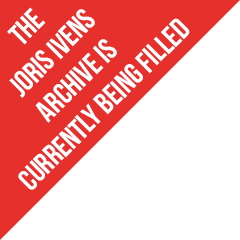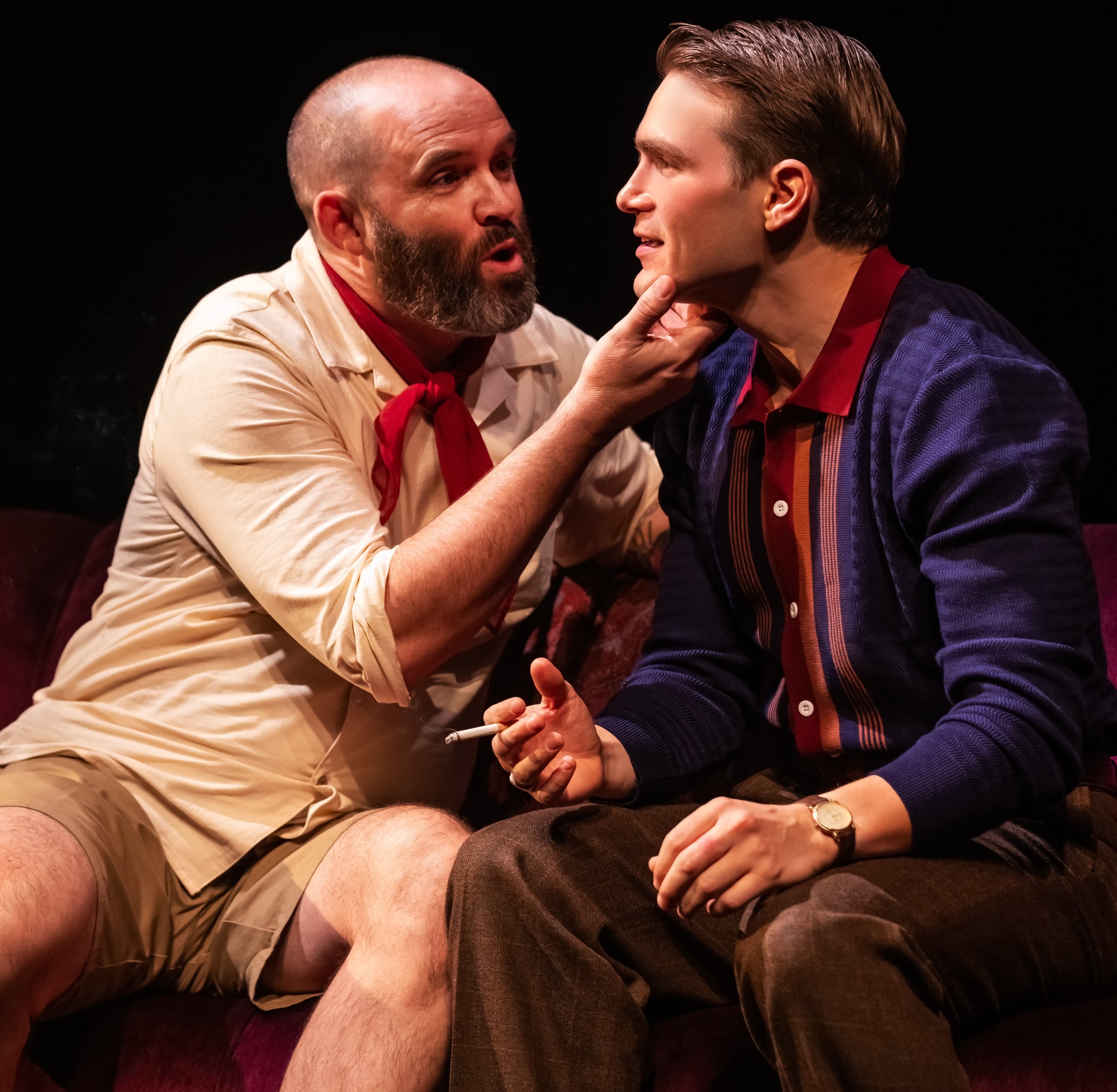

The Second Stage production of Spain in the Tony Kiser Theater in New York presented in December '23 a play about The Spanish Earth with Joris Ivens, Helen van Dongen, Ernest Hemingway and John Dos Passos as the protagonists. Jen Silverman writes that Spain is not “a history play in the most conventional meaning.” It’s “set in 1936 in the West Village,” she says, then adds, “Sort of.” "This 90-minute comedy-drama is an absurdist-tinged fantasy that seizes a moment of history and bends it to the breaking point", she continues. And indeed it is: absurd.
Tony Kiser Theater, 305 West 43rd street
Was Joris Ivens a KGB spy or Helen van Dongen? No, they never were. But Stephen Koch in his fictionalized book about The Spanish Earth and the breaking point between Hemingway and Dos Passos claims this without evidence. Only the looks of Helen van Dongen were already enough to proof this claim, when Koch writes: '...she was just as smart and just as chic - a tricky mix of innocence and experience, small breasted, supple, and so sexy it was a little scary.' The typical looks of a spy, how appropriate, so she must be a spy! Koch clearly never met Helen van Dongen, his quite subjective and little scary description of her, opposites the observations of people who did meet her in real life. According to Koch even John Ferno - oh dear - must have been 'another Comintern appratchik'. John Fernhout must have been shocked by this stupid accusation. Was The Spanish Earth paid by Russian money? No, it wasn't, no penny. It was only paid by Contemporary Historians Inc., the USA intellectuals who raised money for this film with the aim to buy and send ambulances and medical equipment to support the elected democratic government. And they succeeded, the revenues of the distribution of the film were enough to get 17 ambulances to Spain. Ivens himself didn't earn any penny with this production, he was only compensated for his expenses.
So what is the sense of this comedy play? It fits the anti-intellectial climate ignoring facts and making a fool of sincere intentions of artists. This is comedy and at the same time also (s)painful fun.
The play is based on Stephen Kochs' book 'The Breaking Point', which is fictionalized history based on fictionalized fiction of Johan Dos Passos: his very subjective memories of 40 years after the historical events happened, posthumously published in 'Centurys Ebb' in 1975. His memories contain a truckload of proven mistakes, biased by his rightwing political beliefs at that time. A play based on fiction that is based on other fiction results in an absurd story which floats further and further away from what happened in reality. Indeed 'ahistoric' according to the director of the play. With so many contradictory voices and opinions it makes sense again to return to the art work itself and just watch The Spanish Earth and find out yourself.
This is what the creators of this play published on the website:
Jen Silverman’s Spain is inspired by a kernel of historical fact—just a kernel. It concerns a documentary, The Spanish Earth, calculated to rouse sympathy in the United States for Spain’s Second Republic in the long civil war against General Francisco Franco’s fascist insurgency. There was (or, rather, is) such a documentary, produced by Dutch filmmaker Joris Ivens and American editor/producer Helen Van Dongen, released in 1937. A number of noteworthy American intellectuals worked on the film, including novelists Ernest Hemingway and John Dos Passos, playwright Lillian Hellman, actor Orson Welles, poet Archibald MacLeish, and composer Virgil Thomson. In stage directions, Silverman writes that Spain is not “a history play in the most conventional meaning.” It’s “set in 1936 in the West Village,” she says, then adds, “Sort of.” This 90-minute comedy-drama is an absurdist-tinged fantasy that seizes a moment of history and bends it to the breaking point.
Burnap engages with Danny Wolohan (left) as novelist Ernest Hemingway, whom everyone agrees “can be too much.”
ahistoric
Silverman's protagonist-antiheroes are Joris (Andrew Burnap) and Helen (Marin Ireland), self-proclaimed devotees of art, who have accepted Soviet financing for a documentary about wartime Spain and are operating under covert supervision by the KGB. Of the American intellectuals involved in creation of The Spanish Earth, only Hemingway (Danny Wolohan) and Dos Passos (Erik Lochtefeld) are included in the play. These two are famous for their love of Spain and its culture (bullfighting for Hemingway, villages and backroads for Dos Passos). Recruited as celebrity window-dressing, they’re inadvertently lending credibility to a questionable project. Karl (Zachary James), Joris’s KGB “handler,” insists the film should depict the political issues of the Spanish Civil War as straightforward. “War can get so complicated if you try to understand all the different bits” (such as “who did what to whom”), says Karl. “Keep it simple.” Keeping things “simple” means characterizing the war as a black and white conflict between rich and poor, with “the noble peasant crushed by the rich Fascist.” A single-sentence war, Karl contends, “is a perfect opportunity for … ART.” But Joris, narrating the play’s opening scene, cautions that “art” is not “the word [Karl] meant.” With the Roosevelt administration unwilling to intervene in Spain, the KGB aims to gin up U.S. support for the Spanish government as part of a much larger Soviet-Communist plan to deter fascism not only in Spain but throughout Europe. Erik Lochtefeld plays novelist John Dos Passos, recruited to participate in an antifascist documentary that aims to rouse American sympathies for the government side in the Spanish Civil War in Jen Silverman’s ahistorical comedy-drama Spain. On its silky, urbane surface, Spain appears, at first blush, primarily about the tension between art and propaganda. Silverman’s version of Hemingway says that, as a writer, “[y]ou get inside somebody’s brain and you rifle around and you change the connections, you change the neural pathways, and then you change them. And maybe? You save their life.” According to Hemingway, great writing—writing with integrity—is “radical brain surgery.” Helen describes propaganda as similar to that, but different: “the thoughts you have are … formed, shaped, designed to meet a set of specifications, and then served to you. You aren’t having a thought, you’re receiving the thought that someone else crafted for you.” The play’s documentarians are turning out propaganda because it seems clear to them that (as Helen puts it), in the Great Depression economy, “nobody was gonna let me make movies for a living” in any other way. They believe themselves to be in a bind comparable to current-day artists whose work is unsustainable in a society that’s besotted with pop-culture and disinclined to subsidize uncommercial creativity. At times, the cloak-and-dagger shenanigans of Silverman’s intellectuals and their Soviet contacts are reminiscent of digital meddlers in today’s political life. And in the final scene—a coda that lands out of the blue, confirming Silverman’s absurdist bona fides—it’s explicit that Joris, Helen, Hemingway, and Dos Passos are connected in the playwright’s imagination to personnel of Russian troll farms, skulking about cyberspace, spreading disinformation, interfering relentlessly in the civic life of the United States. Zachary James is Karl, the KGB “handler” who has solicited Joris and Helen to produce The Spanish Earth. Directed by Tyne Rafaeli with the melodramatic velocity of early Hollywood espionage dramas such as Watch on the Rhine, Spain barrels over the incongruities of Silverman’s script with hardly a noticeable bump. Using deep shadows, unexpected shifts of illumination, and a series of sliding panels, scenic designer Dane Laffrey and lighting designer Jen Schriever expertly create the atmosphere the playwright requests in her stage directions: “dangerous spy thriller, understated, not cheesy.” With a turntable for cinematic fluidity, the production appears relatively simple, but the creative team provides a myriad of striking details that lift the look and feel of it all far above the ordinary. Despite the presence of actors fully capable of grand star performances (especially, Ireland and Burnap), this first-rate cast is a sturdy ensemble that works together with the balance, rhythm, and mutual-support of Balanchine dancers.